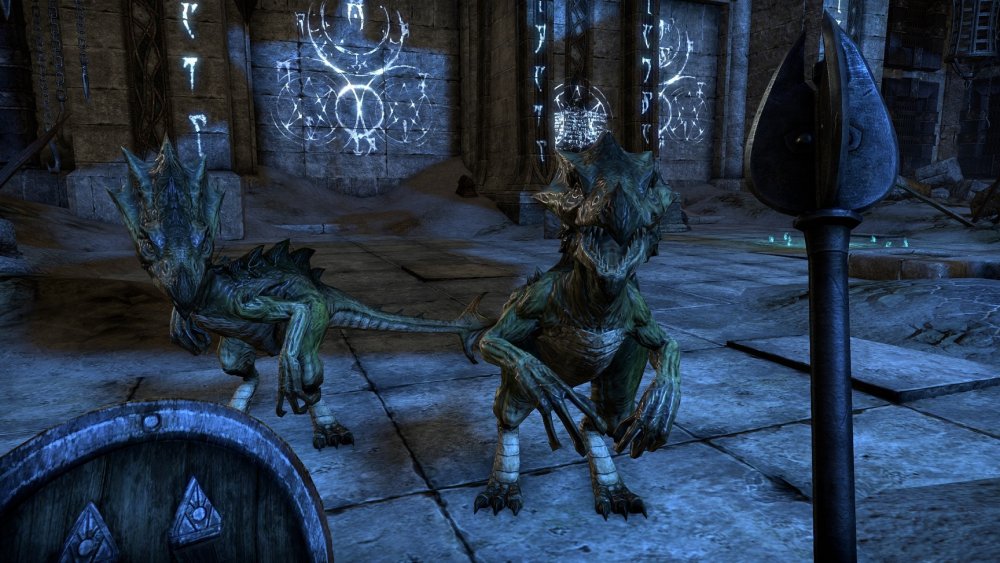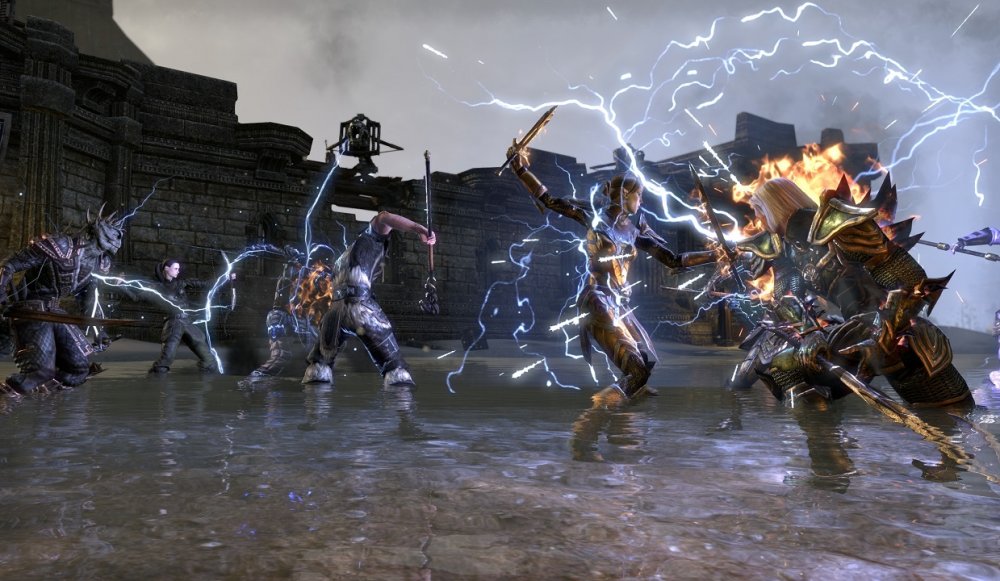

In this months' installment of MMO Co-Opportunities, we're going to take a look at The Elder Scrolls Online. Just about everybody on the staff has been interested in a multiplayer Elder Scrolls game, but the beta was a mixed bag for most of us who played it.
Like any good Elder Scrolls game you begin as a prisoner, this time of Molag Bal. There's a tutorial dungeon that details your escape from his clutches, and along the way, you'll meet the Prophet, who lets you know just how special you are. After you escape imprisonment, you'll be dropped square into the world at large. The game is fully-voiced, much like The Old Republic, and you might hear some familiar voices along the way. The Prophet, for instance, is voiced by Michael Gambon, who most of you youngsters might recognize as Dumbledore.
Rather than taking place in a single region of Tamriel like previous Elder Scrolls games, Elder Scrolls Online contains just about the entire continent. Players are split between three Alliances that cover territory in Tamriel - the Ebonheart Pact, Daggerfall Covenant, and Aldmeri Dominion. There is only one server in ESO, so playing with friends is as simple as creating a character in the same Alliance.

When you create a character in ESO, you choose from four basic classes: The Dragonknight (melee/tanking), Sorcerer (magic), Nightblade (melee/debuffer), and Templar (healer). You also choose your race from the usual Elder Scrolls selection (I made a Khajiit Nightblade, but I don't deal in skooma, sorry). If you sprang for the Imperial Edition of the game, you may choose any race, regardless of Alliance, but all other players must first choose from one of the three Alliances before picking one of its races.
While choosing your class is important in defining your specialties, every character can slot skill points to various armor, weapon, crafting and (NPC) guild-specific abilities. A friend of mine playing the game has actually done an experiment where he only chose a handful of combat abilities, instead focusing on exploration and crafting skills. While this makes him more of a liability in combat, it's encouraging that the system gives a few concessions to people who might want to do some actual roleplaying.
Skill points are treated in an interesting way - while you have an ability from a certain tree slotted to your hotbar, you will gain experience in that line, such as the Assassination tree for Nightblades. As you gain levels, complete certain quests or collect Skyshards in the world, you will also gain skill points to assign. Abilities only become unlocked for you to acquire once you've leveled its parent tree sufficiently. Your abilities may also be morphed into more powerful versions of themselves, should you so choose.

Combat is a hybrid of what you would see in any other Elder Scrolls game and the hotbar-based abilities of your standard MMO. Though the game takes place from the first-person perspective by default, It's a little easier to manage combat in third-person. Elder Scrolls' standard resource bars are present (magicka, stamina), and using abilities will draw from the appropriate pool. Mashing on the left mouse button will use your standard attacks, and you can trigger power attacks by holding it down for longer and moving in a certain direction. The right mouse button provides a block, and if you trigger an attack while blocking, you can bash the enemy to knock it out of spellcasting or its own power attack.
Certain abilities also trigger synergies. While in range of another player who uses an ability that has synergy, you'll be prompted to interact with it, often boosting its power or providing you with a short term buff. In group play, one of the valuable abilities is Blood Funnel, which drops an altar that players can click on and get a boost to their health regeneration. The more players that click it, the more powerful the effect for everybody. My Nightblade has an ultimate ability called Consuming Darkness, which snares enemies in an area and reduces my damage taken. If other players are around, they can interact with it to gain a temporary invisibility and escape combat. Synergies are extremely important, and mastering how to use them is key in defeating most of the group content I encountered.
The three Alliances are also locked in a war to control Cyrodil, the Imperial seat. This is the PVP portion of ESO, called The Alliance War. Once you hit level 10, this option becomes available to players, though I must admit that I haven't put much time into it for this writeup.
Like other Elder Scrolls games, there are dungeons, ruins and caves all over the place. You might expect these to be instanced content, but they're open to anybody who wants to explore. Sometimes they culminate in a miniboss that is soloable, but is best experienced with friends. Luckily, even if you're not grouped, all of those synergies I described above are available. A courteous player will often use synergies to help strangers along.
Certain areas of the world contain powerful monsters or small events that are intended to be taken on as a group. These are similar to the public quests you might see in a game like WAR or Guild Wars 2, but a little smaller in scale. Completing them will give you some nice rewards, but if you see a skull with crossed swords on your minimap, make sure you bring friends.
In addition to the “public” dungeons, there are also sixteen group dungeons throughout Tamriel. There's an NPC guild called the Undaunted that are based primarily on exploring these dungeons, and joining their ranks gives the player access to a skill tree that contains abilities that are essential for completing the dungeons. You'll want a full party of four players if you want to tackle dungeon content, and though there's some built-in group finding capability, it's a lot easier to just organize a party on your own.
Since I was in the Ebonheart Pact, the first dungeon I was able to tackle was the Fungal Grotto in Stonefalls. Like other MMOs, the dungeons in ESO contain a number of sets of trash mobs to clear out and several boss encounters. Unlike other MMOs, however, the bosses are immediately complex, requiring careful interruption of abilities and multitasking, especially when the bosses summon friends. In fact, just about every boss in the place either started with a pack of allies or was able to summon them. Even the giant mudcrab boss. Yes, there's a giant mudcrab boss.
The final boss in the grotto was a giant Dreugh who is able to vortex players into melee range and can immediately wipe your party with a large AOE attack if you're not careful. Being able to escape the range of his attacks is key. He also periodically summons an army of mudcrabs that need to be killed quickly. Completing the dungeon's quest grants you a skill point and unlocks two dungeons that exist in the enemy alliances for exploration. Since you can't explore enemy lands until you've completed the storyline for your faction, this is a welcome feature.
After my time with the beta, I wasn't too impressed, but the retail version of Elder Scrolls Online was able to win me over in the end. It still starts out a little too slowly for my tastes (I probably put 20 hours in before I did my first dungeon), but it's well worth a second look.